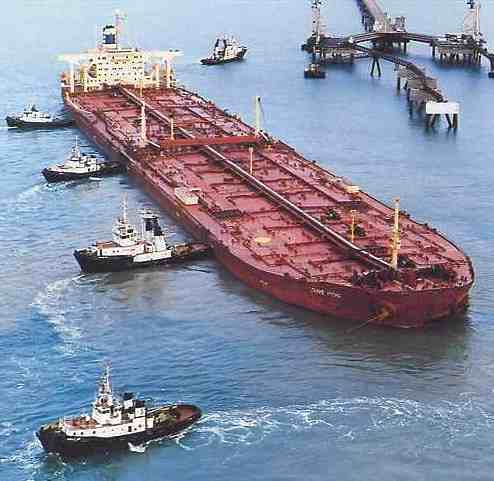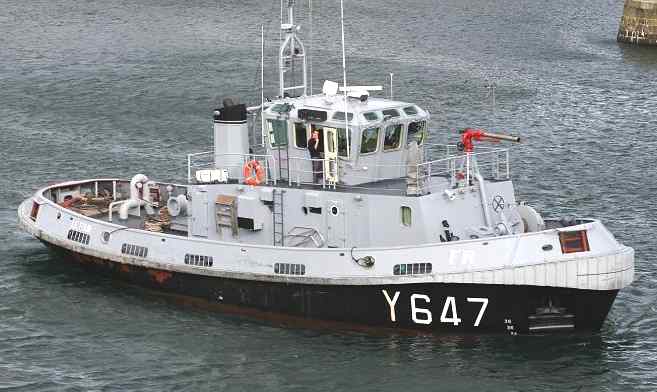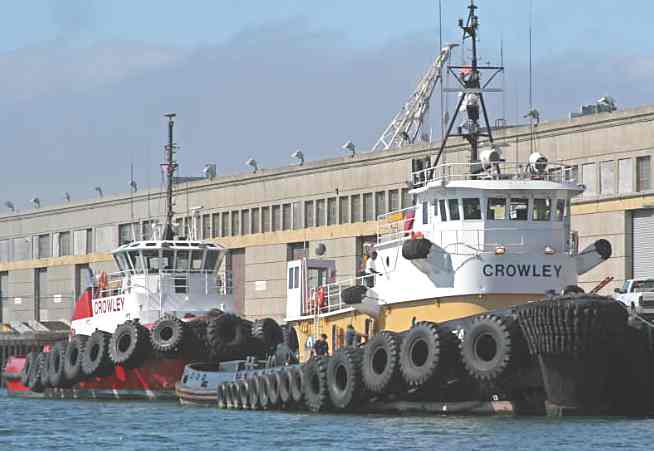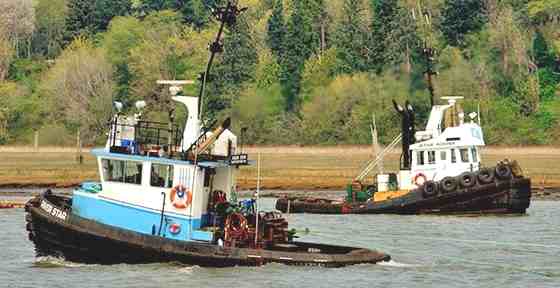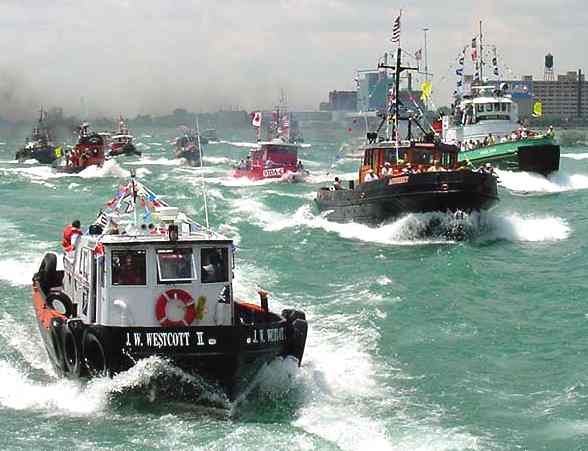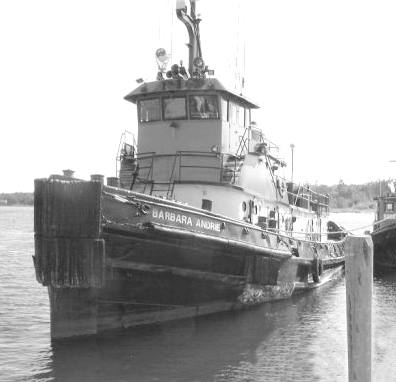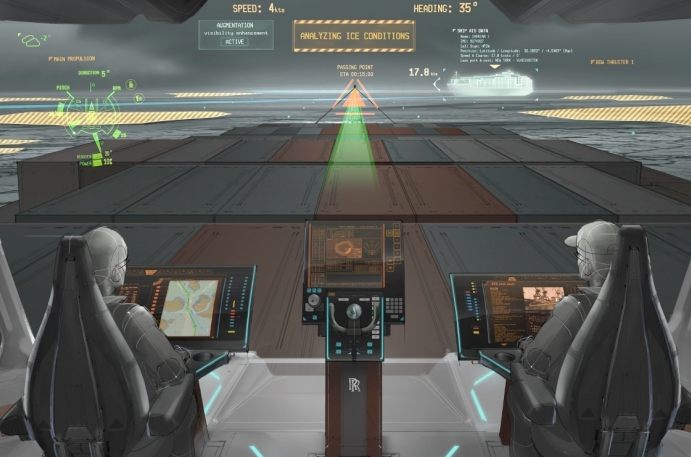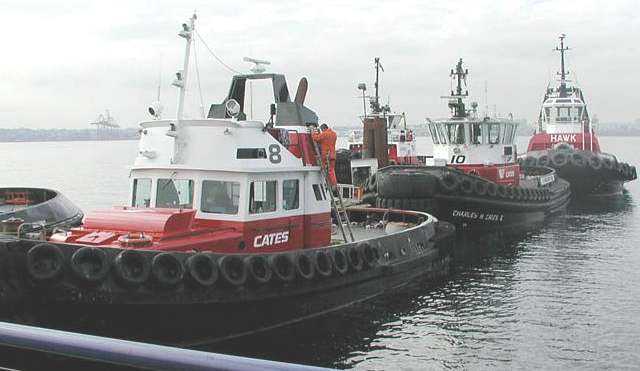|
TUGS
|
||
|
A tugboat, or tug, is a boat used to maneuver, primarily by towing or pushing, other vessels in harbours, over the open sea or through rivers and canals. They are also used to tow barges, disabled ships, or other equipment like towboats.
Tugboat design
Tugboats are quite strong for their size. Early tugboats had steam engines; today diesel engines are used. Tugboat engines typically produce 750 to 3000 horsepower (500 to 2000 kW), but larger boats (used in deep waters) can have power ratings up to 25 000 hp (20 000 kW). The engines are often the same as those used in railroad engines, but typically drive the propeller mechanically instead of converting the engine output to power electric motors, as is common for railroad engines. For safety, tugboats' engines feature two of each critical part for redundancy.
Tugboats are highly maneuverable and various propulsion systems have been developed to increase maneuverability and increase safety. The earliest tugs were fitted with paddle wheels but these were soon replaced by propeller-driven tugs. Kort nozzles have been added to increase thrust per kW / hp. This was followed by the nozzle-rudder which omitted the need for a conventional rudder. The cycloidal propeller was developed prior to World War II but was only occasionally used in tugs because of its manoeuvrability. After World War II it was also linked to safety due to the development of the Voith Water Tractor; a tugboat configuration which could not be pulled over by its tow. In the late 1950s the Z-drive or (azimuth thruster) were developed. Although sometimes referred to as the Schottel system many brands exist: Schottel, Z-Peller, Duckpeller, Thrustmaster, Ulstein, Wärtsilä etc. The propulsion system are used on tugboats designed for tasks such as ship docking and marine construction. Conventional propeller/rudder configurations are more efficient for port-to-port towing.
The Kort nozzle is a sturdy cylindrical structure around a special propeller having minimum clearance between the propeller blades and the inner wall of the Kort nozzle. The thrust:power ratio is enhanced because the water approaches the propeller in a linear configuration and exits the nozzle the same way. The Kort nozzle is named after its inventor, but many brands exist.
A new type of tugboat has been invented in the Netherlands. The so-called carousel tug consists of a design wherein the flexibility and effectiveness of the tugboat's maneuvers is determined not by the propulsion system, but by a steel construction on deck, consisting of two steel rings. The inner ring is fixed to the ship, and the second ring rotates freely and carries a hook or winch. The ship can therefore maneuver freely and independently of the towed ship, and since the towing point rotates towards the point nearest to the towed ship, the tug can capsize only with difficulty. One prototype exists presently, but the first new tugs are expected to sail in spring 2007.
Tugboat Le Four manoeuvering in Brest harbor
Types of tugboats
There are two groups of tugboats, either Inland or Oceangoing.
Harbor tugs are the most typical of the tugboats that people recognize. They are used worldwide to move ships in and out of berth and to move industrial barges around waterfront business complexes. Their job has remained the same but their design and engineering has changed much over the the decades. Harbor tugs have evolved from paddle wheelers, to the conventional tug known by all, and now to the Ship Docking Moduals and tractor tugs in the modern industry.
River tugs are also referred to as towboats or pushboats. They are designed as large squared off vessels with flat bows for connecting with the rectangular stern of the barges. They are large and powerful, most commonly seen on the big rivers of the world. They are capable of pushing huge fleets of barges that are lashed together into "tows". Some tows can be up to 1000 feet long and 200 feet wide. Smaller push boats are often seen handling only a few barges on inland waters. Despite their size, they are designed to push their tow rather than tow from the stern.
The conventional tug is the standard seagoing tugboat with a model bow that tows its payload on a hawser. A hawser is the nautical term for a long steel cable or large synthetic fiber rope. It operates independently and is used to tow various loads, e.g., cargo barges, ships, oil rigs, and etc. This is the most versatile method of towing since the conventional tugboat is able to move its load three ways: Pushing from behind, secured to the side of the towed vessel, or by towing astern, all achieved by the use of various lines and cables in various configurations, usually tires hung all along the side of the boat. In addition, the conventional tug has heavy but soft fenders all around it and mounts no external equipment that can prevent it from working in close contact with any vessel or floating object. They are importantly recognized as the design of choice for salvage and assistance of wrecked ships and in the rescue and safe return of disabled ships from the high seas.
The notch tug is a conventional tug which is assigned to tow and push a specific barge, usually built to the shape and specifications of that tugboat. A notch tug has a large towing winch on its stern but it gets its name from the deep notch built into the stern of the barge. This notch is built in the exact shape of the tug's forward hull and can be quite deep, up to 90 feet, sometimes more. The tugboat fits snugly into the notch of the barge and with the use of various lines can be secured firmly enough to push the barge at much higher speeds than it would if it were towing. The towing hawser remains rigged during pushing. In the event that the seas get too rough to push safely, the tug merely releases any securing lines and backs out of the notch while extending its towing hawser. Once in calmer waters, the tug can maneuver back into the notch and resume pushing.
River Tugboats
The articulated tug and barge, or ATB, is a specially designed vessel, comprised of a tugboat and a barge which are coupled using specially designed machinery. The tug is connected to the barge inside a notch, similar to the notch boat, using a system of heavy pins, clamps, and/or side pads. ATB's remain coupled all the time; the tug pushes its barge in all but the roughest seas.
The integrated tug and barge, or ITB, is a rigidly connected tug and barge. This means that it fits so tight into the stern of its barge that it will roll and pitch in the same manner with the barge. The systems used to couple the two vessels are varied, but they are similar in that the connection point is virtually seamless and for all practical purpose, they appear to be a ship. These units stay coupled under any sea conditions and the tugs usually have poor designs for sea keeping and navigation without their barges attached. Vessels in this category cannot pitch independently from the barge and so are legally considered to be ships rather than tugboats and barges. As a result of this classification, they are regulated by authorities as ships.
Rolls Royce - Autonomous boat head up display
Operational tugs
Tugboats in fiction
To date there have been two childrens's shows revolving around anthropomorphic (living) tugboats. In the 1980s 13 episodes were made of TUGS. One of the creators of that series went on to make Theodore Tugboat. On Tugs the models were able to move their heads and eyes and didn't have motors. On Theodore Tugboat, the models have motors and moving eyes. Tugboats have also been featured on Thomas and Friends however they have been reused from Tugs and have no face nor a hat.
The spaceship Nostromo of the movie Alien could be considered a tug.
LINKS and REFERENCE
Some pictures of tugboats and tugboat building
Tugboats in Vancouver, British Columbia
Healthier alternative tastes for adventure capitalists
Solar Cola | Solar Crush | Solar Citrus | Solar Spice
|
||
|
This website is Copyright © 1999 & 2014 Max Energy Limited, an environmental educational charity working hard for world peace. The names Solar Navigator™,Blueplanet BE3™, Ecostar DC50 ™ are trademarks. All other trademarks are hereby acknowledged.
|
